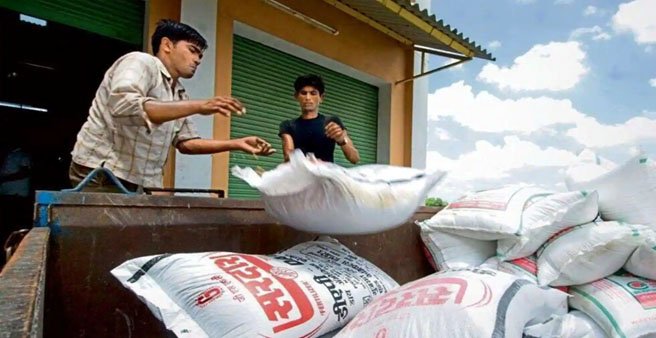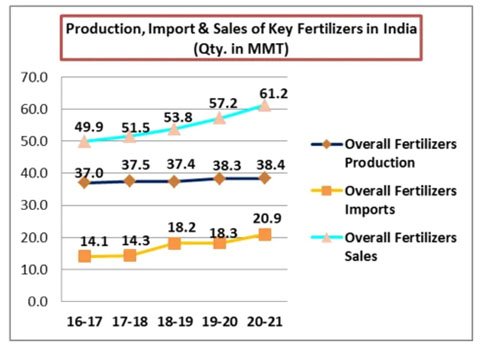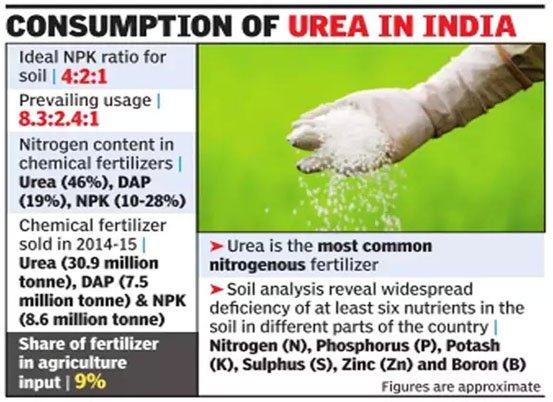INDIA’S NEW FERTILIZER POLICY

CONTEXT : As the government is expected to come out with a new fertilizer policy, NITI Aayog has set up a task force to examine production and promotion of bio-fertilizer and organic fertilizers in India.
- Agricultural policy reform is one of the major challenges facing India today. Such reform is required in order to reduce poverty through faster agricultural growth and to promote more sustainable use of natural resources while ensuring food security.
- The debate on fertilizer subsidy, as well as all other agricultural subsidies in India, should be examined against the backdrop of India’s overall economic situation, the prominence of farmers and the agricultural sector in India’s political economy, and recent trends in the Indian agricultural economy.
INDIA’S CURRENT FERTILIZER PRODUCTION & CONSUMPTION

- Over the years, fertilizer production in India has increased drastically; from an annual production of 22.23 MMT (million metric tonnes) in 1990–1991 to 43.66 MMT in 2021–2022.
- Total consumption of fertilizers between April and mid-December 2022 was 40 million metric tonnes (mmt).
- India produced 32 mmt of fertilizers and imported 12 mmt of fertilizers.
TREND OF GOVERNMENT’S FERTILIZER EXPENDITURE
- As Ukraine war spiked the government’s spending on food, fertilizer and fuel subsidy by nearly 70%.
- For 2023-24, the fertilizer ministry might seek budgetary support of ₹2.5 trillion subsidy as outgo for FY23 has already crossed ₹2 trillion.
- Russia being a major exporter of LNG, which is a critical input for manufacturing of urea has also led to price hikes.
IMPACTS OF CURRENT FERTILIZER POLICY
- Heavy subsidies have prompted many farmers to use chemical fertilizers like urea, which leads to higher productivity, but affects soil fertility in the long run.
- Excessive and inefficient use of fertilizers leads to nutrient losses to the environment and also result in drinking water contamination and impact human lives as a result of unsafe storage practices.

- Subsidy being released directly to companies, technology-inefficient companies are being protected.
NEED OF A NEW FERTILIZER POLICY
As the government is expected to come out with a new fertilizer policy, NITI Aayog has already set up a task force to examine production and promotion of bio-fertilizer and organic fertilizers in India.
The new fertilizer policy should envisage the following features:
- Lowering duty on imported phosphoric acid to raise the competitiveness of local fertilizer manufacture.
- Incentive for promoting production and consumption of organic fertilizers.
- Subsidy normalization and harmonization of market.
What is the One Nation One Fertilizer (ONOF) Scheme?
- Under the scheme all manufacturers participating in the Center’s fertilizer subsidy scheme will be required to use a single brand and logo for fertilizers.
- All types of fertilizers, including Di-ammonium Phosphate (DAP), Nitrogen, Phosphorus, Potassium (NPK), and urea, will be sold under the brand name “Bharat”.
- ONOF is viewed as a game-changer for India’s agrarian economy as it will clear up the confusion of farmers regarding the availability and quality of fertilizers and will also led to reduction of the cost and increase their availability.
STEPS TAKEN BY CENTRAL GOVERNMENT IN 2022
Government took some steps to improve availability of fertilizers such as:
- Assessment of state-wise requirement every month
- 100% neem coating of urea
- Neem coated urea increases nutrient efficiency
- Monitoring of crop yield and soil health
- Online monitoring of the movement of fertilizers through the integrated Fertilizer Monitoring System.
- The department of fertilizers disbursed subsidies for urea and nutrient-based subsidy, and implemented direct benefit transfer.
- The existing village, block/sub district/taluk and district level fertilizer retail outlets are being converted into model fertilizer retail outlets.
WAY FORWARD
- Many policymakers has suggested to shift the fertilizer subsidy from fertilizer corporations to the bank accounts of farmers. It is expected that the planned direct cash transfer (DCT) will promote farmers to use fertilizer judiciously and effectively while lowering program administrative costs for the Government.
- Regulating the usage of urea as its excessive usage is harming the environment and also costing heavy loads on government exchequer.
- Dedicated digital database will reduce the government’s struggle to accurately target the beneficiaries, which will further reduce its expenditure on the subsidy and prevent leakages.
Syllabus : MAINS, GS-3 AGRICULTURE & ENVIRONMENT


